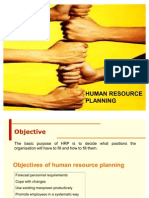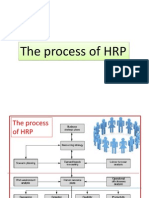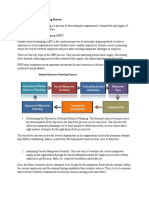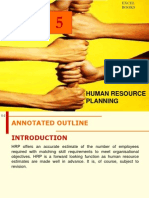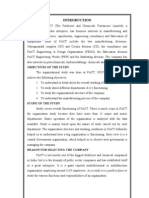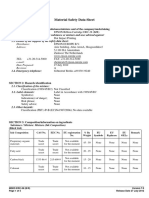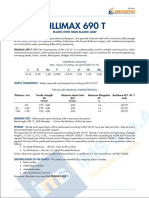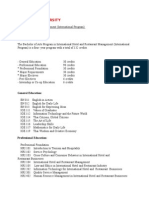Module 4
Module 4
Uploaded by
Sreejith C S SreeCopyright:
Available Formats
Module 4
Module 4
Uploaded by
Sreejith C S SreeCopyright
Available Formats
Share this document
Did you find this document useful?
Is this content inappropriate?
Copyright:
Available Formats
Module 4
Module 4
Uploaded by
Sreejith C S SreeCopyright:
Available Formats
Human Resource Planning
Definition: The ongoing process of systematic planning to achieve optimum use of an organization's most valuable asset - its human resources. The objective of human resource (HR) planning is to ensure the best fit between employees and jobs, while avoiding manpower shortages or surpluses. The three key elements of the HR planning process are 1. Forecasting labor demand 2. Analyzing present labor supply 3. Balancing projected labor demand and supply. Objectives and Importance of Human Resource Planning: 1. 2. 3. 4. 5. 6. 7. 8. 9. 10. 11. 12. Assessing manpower needs for future and making plans for recruitment and selection. Assessing skill requirement in the future. Determining training and development needs for the organization. Determining surplus and shortage of the staff and avoiding unnecessary detention or dismissal. Controlling wages and salary costs. Ensuring optimum use of HR. Helping organization to cope up with Technological advancements. Ensuring high labor productivity. Focus on Career planning of every employee. Taking care of succession planning. Ensure promotion of employees in systematic manner. It involves hiring, development and retention of HR.
Human Resource Planning Process: 1. The mission & vision of the organization: The organization should be clear about its mission & objectives. The manpower planning must be integrated with other business policies such as profitability, production, sales &development. Any change in the business objectives would certainly affect the manpower planning. The ultimate aim of manpower planning should be to relate future human resource to future enterprise need so as to maximize the future ROI. 2. SWOT Analysis: After organization has fixed the goals & objectives, the next step is the corporate assessment. The company now begins to analyze its goals, current strategies, external environment, strengths & weaknesses, opportunities &threat, to know whether they can be able to achieve with the current human resource. The SWOT ( Strengths, weakness, opportunities, & threats). The SWOT analysis will give the clear picture about the organization resources such as capital& worker it will also indicate departmental abilities such as training & development, marketing, accounting, research
and development & management information system. This SWOT analysis serves as the link between the organization goals & the way or direction in which the organization should go to meet its objectives.
3. Man power Forecasting: Forecasting of future manpower requirement is the most important part of manpower planning. It is done on the basis of production & sales budgets, workloads analysis, work force analysis, estimated absenteeism & turnover. The future manpower requirements should be forecasted quantitatively& qualitatively. There are several factors which need to be looked upon before forecasting. (a) Employment Trend: The manpower planning committee should compare & analyze the trend of last five year to forecast the manpower requirements. (b) Productivity: Manpower requirements are also influenced by improvement in productivity. The important three aspects are . Better utilization of existing manpower. . Improvement in technology. . Matching of skills with job requirement. (c) Absenteeism: Absenteeism is a situation when a person fails to come for work when he is scheduled to work. While estimating demand for manpower the prevailing rate of absenteeism in the organization should be considered. (d) Expansion & Growth: Expansion & growth plans of the organization should be carefully analyzed to judge their impact on manpower requirement in future. Forecasting Techniques: (a) Expert Forecasts: Demand is modified by retirements, terminations, resignations, deaths and leaves of absence. Past experiences make these occurrences quite predictable. (b) Trend analysis: HR needs can be estimated by examining past trends. Eg: 2001-02 Production of units: 5000 2002-03 No of workers : 100 2003-04 Ratios : 100: 5000 2003-04 Estimated Production: 8000 Number of workers required : 8000*100/5000=160 To proceed systematically HR generally follow three steps: a) Work Force Analysis: The average loss of manpower due to leave, retirement, death, transfer, discharge etc. during the last 5 years may be taken into account.
IN OUT Transfers in---------------------------------------------------------->Job Hopping Transfers out Retirement Recruits in------------------------------------------------------------>VRS Scheme Discharge or dismissal Terminations Promotions in--------------------------------------------------------->Resignations Retrenchment Attractions in other companies etc. Fig: Manpower flows in a company b) Work Load Analysis: The need for manpower is also determined on the basis of work-load analysis, wherein the company tries to calculate the number of persons required for various jobs with reference to a planned output-after giving weight age to factors such as absenteeism, idle time etc. E.g.: Planned output for the year Standard hours per piece Planned hours required Productive hours per person Number of workers required 10000 pieces 3 hours 30000 hours 1000 hours 30
c) Job Analysis: Job analysis helps finding out the abilities or skills required to do the job efficiently. It means a detailed study of jobs to identify the qualifications and experience required for them. 4. Manpower Plan: After forecasting about the right type & number of people required the next phase is to plan, how the organization can obtain these people. Programs & strategies need to developed for recruitment, selection, training, internal transfers, promotions &appraisal so that the future manpower requirement can be met. Development plans are designed to ensure a continuing supply of trained people to take over jobs as they fall vacant either by promotion or recruitment or through training. In this way, shortages or redundancies can be avoided in the long run. Preparing Manpower Inventory is a very important step for the plan to be implemented successfully.
Man Power Inventory: It is the records of staff in a commercial organization. It helps to find out the size and the quality of the employees presently in the organization at various positions. Every organization will have two major sources of supply of manpower: External and Internal. a) Internal Labor Supply: 1. Staffing Table: It shows the number of employees in each job. It tries to classify employees on the basis of age, sex, position, category, experience, qualification, skills etc. A study of the table indicates if the current employees are properly utilized or not.
2. Markov Analysis: It uses the historical data of promotions, transfers, and turnover to estimate the future availabilities in the workforce. Based on the past probabilities one can estimate the number of employees who will be in various positions with the organization in future.
2003-2004 Store Managers (n=15)
Store Managers
80%
Asst. Store manager
Section Head
Dept. Heds
Sales Executive
Exit
20%
12 Asst. Store Manager (n=36)
11% 83% 6%
4 Section Heads (n=94)
30
11%
66%
8%
15%
11
63
14
Departmental Heads (n=288)
10%
72 %
2%
16%
29
207
46
Sales Executives (n=1440)
6%
74%
20%
86
1066
288
Forecasted Supply
16
41
92
301
1072
353
3. Skills Inventory: It is anss assessment of the knowledge, skills, abilities, experiences and career aspirations of each of the current employees. It should be updated atleast every two years.
4. Replacement Chart: It shows the profile job holders department wise and offers a snapshot of who will replace whom if there is a job opening.
b) External Labor Supply: When the organization grows rapidly and diversifies into newer areas of operations (merchant banking, capital market operations, mutual funds etc. in the case of a bank) or when it is not able to find the people internally to fill the vacancies it has to look into outside sources. To the extent an organization is able to anticipate its outside recruitment needs and looks into the possible sources of supply keeping the market trends in mind, its problems in finding the right personnel with appropriate skills at the required time would become easier. Important Barometers of Labor supply: 1) Net migration into and out of the area. 2) Education levels of workforce 3) Demographic changes in population. 4) Technological developments and shifts 5) Population Mobility 6) Demand for specific skills 7) National regional unemployment rates 8) Actions of competing employers 9) Government policies, regulations, pressures. 10) Economic Forecasts for the next few years. 11) The attractiveness of an area. 12) The attractiveness of an industry in a particular place. Determining Manpower gaps: The existing number of personnel and their skills (from human resources inventory) are compared with the forecasted manpower needs ( demand forecasting) to determine the quantitative and qualitative gaps in the workforce. A reconciliation of demand and supply forecasts will give us the number of people to be recruited or made redundant as the case may be. This forms the basis for preparing the HR plan . Below Exhibit shows how demand and supply forecasts can be related over a period of three years. 5. Determining Human Resources Requirements:
1) Number required at the beginning of the year 2) Changes to requirements forecast during the year DEMAND
3) Total requirements at the end of the year (1+2) 4) Number available at the beginning of the year 5) Additions (transfers, promotion) SUPPLY 6) Separations (retirement, wastage, promotions out and other losses). 7) Total available at the end of years ( 4+ 5+ 6) 8) Deficit or surplus ( 3 -7) 9) Losses of those recruited during the year-Reconciliation of the above manpower needed. 10) Additional numbers needed during the year (8+9) 6. Formulating HR plans: Organizations operate in a changing environment. Consequently Human resources requirements also change continually. Changes in product mix, union agreements, competitive actions are some of the important things that need special attention. The human resource requirements identified along the procedure outlined in the above box need to be translated into concrete HR plans backed up by detailed policies programs and strategies (for recruitment, selection., training, promotion, retirement, replacement etc) 1. Recruitment plans: Will indicate the number and type of people required and whom they are needed for, special plans to recruit right people and how they are to be dealt with via the recruitment program. 2. Redeployment plan: Will indicate the programs for transferring or retraining existing employees for new jobs. 3.Redundancy plan: Will indicate who is redundant when and where the plans for retraining where this is possible and plans for golden handshake retrenchment lay off etc. 4. Training plan: Will indicate the number of trainees or apprentices required and the programs for recruiting; of training them, existing staff requiring training or refraining new courses to be developed or changes to be effected in existing courses 5. Productivity plan: Will indicate reasons for employees productivity or reducing employee costs through work simplification studies, mechanization productivity, bargaining incentives and profit sharing schemes , job redesign etc. 6. Retention plan: will indicate reasons for employee turnover and show strategies to avoid wastage through compensation policies , changes in work requirements and improvement in working conditions. 7. Control points: The entire manpower plan to be subjected to close monitoring from time to time . Control points be set up to find out deficiencies periodic updating of manpower inventory in the light of changing circumstances be undertaken to remove deficiencies and develop future plans.
Effectiveness of Human resource Planning: 1. Objectives: The Hr plan should fit with the overall objectives of the organisation. 2. Top Management support: To meet the changing needs of the organisation, there should be support of the Top Management. 3. Employee skills Inventory: Upto date employee skill inventory should be maintained by the org. Tis can be done with in the form of Markov Analysis, skill inventory table etc. 4. HRIS: Implement computer technology to maintain Human skill inventory. 5. Coordination: Procurement, promotion and retention plans must be integrated properly.
You might also like
- A Project Report On Company AnalysisDocument27 pagesA Project Report On Company Analysissamharry5358% (12)
- UNIT 3 - HR Inventory PDFDocument15 pagesUNIT 3 - HR Inventory PDFPurnima Singh71% (7)
- Human Resource PlanningDocument21 pagesHuman Resource Planningincpatna100% (4)
- HRPDocument24 pagesHRPsaloniNo ratings yet
- Chapter - 5 Human Resource PlanningDocument37 pagesChapter - 5 Human Resource Planningmoni314No ratings yet
- Demand ForecastingDocument7 pagesDemand ForecastingVivek RaoNo ratings yet
- Demand and Supply ForecastingDocument19 pagesDemand and Supply ForecastingBattu Kaur100% (1)
- HRP - HRRDocument12 pagesHRP - HRRDeepak SharmaNo ratings yet
- Unit V Human Resource Planning in Nepal:-Demographic Trend AnalysisDocument5 pagesUnit V Human Resource Planning in Nepal:-Demographic Trend AnalysisSujan Chaudhary100% (1)
- Models and Techniques of Manpower Demand and Supply ForecastingDocument27 pagesModels and Techniques of Manpower Demand and Supply ForecastingReetika DadheechNo ratings yet
- 2 - HR PlanningDocument23 pages2 - HR PlanningSushant ChaurasiaNo ratings yet
- HRM - 2nd Week - Lecture HandoutDocument14 pagesHRM - 2nd Week - Lecture HandoutProf. Jomar MariquitNo ratings yet
- Human Resource Planning & RecruitmentDocument37 pagesHuman Resource Planning & RecruitmentShivam KhannaNo ratings yet
- The Process of HRPDocument22 pagesThe Process of HRPdpsahooNo ratings yet
- HRPDocument60 pagesHRPSunita MehtaNo ratings yet
- Human Resource PlanningDocument8 pagesHuman Resource PlanningAkum obenNo ratings yet
- Manpower PlanningDocument38 pagesManpower PlanningGazal ReyazNo ratings yet
- Manpower PlanningDocument38 pagesManpower PlanningTuhin Subhra SamantaNo ratings yet
- Human Resources Audit QBDocument21 pagesHuman Resources Audit QBGeeta BhatiaNo ratings yet
- Manpower Planning - Setting The ToneDocument31 pagesManpower Planning - Setting The TonePreeti TanejaNo ratings yet
- 2 - HRP, Gallagher HR Estimator Nad Cohort AnalysisDocument19 pages2 - HRP, Gallagher HR Estimator Nad Cohort Analysisdsravani50% (2)
- A Note On Manpower PlanningDocument6 pagesA Note On Manpower PlanningDarel WizNo ratings yet
- HRM Unit 2 NotesDocument20 pagesHRM Unit 2 Notessebaseg342No ratings yet
- HRP Finel 1Document16 pagesHRP Finel 1kaliya420No ratings yet
- Human Resource PlanningDocument6 pagesHuman Resource PlanningPankaj2cNo ratings yet
- Human Resource Planning ProcessDocument7 pagesHuman Resource Planning ProcessFiker Er MarkNo ratings yet
- Human Resource PlanningDocument5 pagesHuman Resource PlanningLatha HarishNo ratings yet
- 3rd Sem MPPDocument39 pages3rd Sem MPPprovidence6sigmaNo ratings yet
- HRM - 2nd Week - Lecture NotesDocument8 pagesHRM - 2nd Week - Lecture NotesProf. Jomar MariquitNo ratings yet
- Human Resource Planning 2Document36 pagesHuman Resource Planning 2Dheeraj KumarNo ratings yet
- Human Resource Management - Unit 2 (B.com) - 2024Document19 pagesHuman Resource Management - Unit 2 (B.com) - 2024Shrey BankaNo ratings yet
- According To: Blum, "A Job Analysis Is An Accurate Study of The Various JobDocument4 pagesAccording To: Blum, "A Job Analysis Is An Accurate Study of The Various Jobpriyanshi rankaNo ratings yet
- Manpower Planning & Resourcing Mu001 B0816Document11 pagesManpower Planning & Resourcing Mu001 B0816anithanhNo ratings yet
- Human Resource Management - Unit 2 (B.com) - 2024Document26 pagesHuman Resource Management - Unit 2 (B.com) - 2024Shrey BankaNo ratings yet
- HR PlanningDocument47 pagesHR PlanningPriyanka Joshi0% (1)
- Manpower Planning MP Meaning Steps and Techniques Manpower PlanningDocument8 pagesManpower Planning MP Meaning Steps and Techniques Manpower PlanningGajanan PanchalNo ratings yet
- Manpower Planning (MP) Meaning, Steps and Techniques Manpower PlanningDocument8 pagesManpower Planning (MP) Meaning, Steps and Techniques Manpower PlanningAzwinNo ratings yet
- Human Resource PlanningDocument25 pagesHuman Resource Planningjoginder GrewalNo ratings yet
- HRM Notes 2,3,4,5Document31 pagesHRM Notes 2,3,4,5Ashwin NathanNo ratings yet
- 4 HRPlanningDocument15 pages4 HRPlanningDivya SubramanianNo ratings yet
- THISDocument4 pagesTHISkatedutta2No ratings yet
- Chapter 05Document12 pagesChapter 05Sakshi SharmaNo ratings yet
- Lecture 4Document28 pagesLecture 4ALIS VERİSNo ratings yet
- Ritu TiwariDocument13 pagesRitu Tiwarigoldieahuja16No ratings yet
- LASTDocument3 pagesLASTkatedutta2No ratings yet
- HR Demand Forecasting: Human Resource PlanningDocument2 pagesHR Demand Forecasting: Human Resource PlanningDebanjan DebNo ratings yet
- Objectives of Merit RatingDocument25 pagesObjectives of Merit Ratingnitish kumar twariNo ratings yet
- Manpower Planning/Human Resource Planning: Definition & ConceptDocument8 pagesManpower Planning/Human Resource Planning: Definition & ConceptSimran KourNo ratings yet
- HRM Report - Human Resource PlanningDocument32 pagesHRM Report - Human Resource PlanningKeith Amor100% (1)
- HR Forecasting TechniqueDocument3 pagesHR Forecasting TechniqueDavid Wong100% (4)
- Process of HRPDocument3 pagesProcess of HRPVazhaNo ratings yet
- Human Resource Planning, Job Analysis & Design: Unit 2Document77 pagesHuman Resource Planning, Job Analysis & Design: Unit 2AlbertNo ratings yet
- Human Resource Demand ForecastingDocument5 pagesHuman Resource Demand ForecastingPreetham Vincent Lobo100% (1)
- Lecture Four Q. 1) What Is Manpower Planning? Discuss The Process & Importance of Manpower Planning in An Organization. (20M)Document3 pagesLecture Four Q. 1) What Is Manpower Planning? Discuss The Process & Importance of Manpower Planning in An Organization. (20M)Sneha DaswaniNo ratings yet
- HR ForecastingDocument8 pagesHR ForecastingUzair Ul Ghani100% (1)
- TOPIC 4-HUMAN RESOURCE PLANNING JOB ANALYSIS Doc 2023Document9 pagesTOPIC 4-HUMAN RESOURCE PLANNING JOB ANALYSIS Doc 2023Peter Kimani100% (1)
- People Resourcing Strategy...Document50 pagesPeople Resourcing Strategy...ابوعركي عثمانNo ratings yet
- Human Resource PlanningDocument21 pagesHuman Resource PlanningmetahelpcentermanagementNo ratings yet
- HRPDocument24 pagesHRPBhavarth DekhaneNo ratings yet
- Solutions for Forecasting Manpower Needs in an Organization!From EverandSolutions for Forecasting Manpower Needs in an Organization!No ratings yet
- Selection: - Meaning of SelectionDocument2 pagesSelection: - Meaning of SelectionSreejith C S SreeNo ratings yet
- Module 7Document9 pagesModule 7Sreejith C S SreeNo ratings yet
- Human Resource ManagementDocument23 pagesHuman Resource ManagementSreejith C S SreeNo ratings yet
- Goals /objective: Need For HRDDocument8 pagesGoals /objective: Need For HRDSreejith C S SreeNo ratings yet
- B U NotesDocument19 pagesB U NotesSreejith C S SreeNo ratings yet
- Chapter 1 HRMDocument6 pagesChapter 1 HRMSreejith C S SreeNo ratings yet
- Compensation 8th Module NotesDocument45 pagesCompensation 8th Module NotesSreejith C S SreeNo ratings yet
- Services Marketing: 1. What Are Services? Categorize ThemDocument16 pagesServices Marketing: 1. What Are Services? Categorize ThemSreejith C S SreeNo ratings yet
- A Study On Training and Development Process in Human Resources Consulting FirmDocument9 pagesA Study On Training and Development Process in Human Resources Consulting FirmSreejith C S SreeNo ratings yet
- A Study On Training and Development Process in H R Consulting FirmDocument9 pagesA Study On Training and Development Process in H R Consulting FirmSreejith C S SreeNo ratings yet
- FACT Project - JKDocument72 pagesFACT Project - JKSreejith C S Sree100% (1)
- Business Ethics Module 1Document20 pagesBusiness Ethics Module 1Sreejith C S SreeNo ratings yet
- SDS Ptib 338074 2015-12-21Document5 pagesSDS Ptib 338074 2015-12-21gcalidadNo ratings yet
- Oracle AGIS - IntercompanyDocument8 pagesOracle AGIS - IntercompanyAmitNo ratings yet
- Refrigerant Chart: R1234yf & R744 (CARBON DIOXIDE)Document1 pageRefrigerant Chart: R1234yf & R744 (CARBON DIOXIDE)onixadyNo ratings yet
- Dormitory Rules and Regulations Contract Revised v2Document1 pageDormitory Rules and Regulations Contract Revised v2MJ ArcillaNo ratings yet
- Generator Set Data Sheet Hza3 6 t5 Portable EnglishDocument6 pagesGenerator Set Data Sheet Hza3 6 t5 Portable EnglishOomar DooreemeahNo ratings yet
- Letter To The RespondentsDocument1 pageLetter To The RespondentsRosalie Valdez EspirituNo ratings yet
- Acer Aspire E1-510 - Compal La-A621p (Z5we3. Z5WT3)Document38 pagesAcer Aspire E1-510 - Compal La-A621p (Z5we3. Z5WT3)Ivanée CarelliNo ratings yet
- Game Theory: Managerial Decision ProcessDocument9 pagesGame Theory: Managerial Decision ProcessHimel NisarulNo ratings yet
- 35 - Salary Slip FormatDocument1 page35 - Salary Slip FormatAsif Rahman0% (1)
- MGA Policy On Outsourcing by Authorised PersonsDocument15 pagesMGA Policy On Outsourcing by Authorised PersonsMaria CECILIA S CARMONANo ratings yet
- Dillimax 690 T: Plates With High Elastic LimitDocument2 pagesDillimax 690 T: Plates With High Elastic LimitAnonymous AlhzFE9EVNNo ratings yet
- ECE 461/561-001: Communication Systems Design: Min MaxDocument5 pagesECE 461/561-001: Communication Systems Design: Min MaxZhenyu HuoNo ratings yet
- G.R. No. 192088Document15 pagesG.R. No. 192088Giuliana FloresNo ratings yet
- Concept of Owner Vs Concept of HolderDocument2 pagesConcept of Owner Vs Concept of HolderAljay DAHANNo ratings yet
- Turbo Machine: Radial Rotor (Impeller) Shroud Blade Axial Flow Out Axial Flow in or Vane Flow OutDocument6 pagesTurbo Machine: Radial Rotor (Impeller) Shroud Blade Axial Flow Out Axial Flow in or Vane Flow OutKaushal SharmaNo ratings yet
- Can CTRL UsgDocument42 pagesCan CTRL UsgShakeebNo ratings yet
- Chapter 4: Requirement EngineeringDocument44 pagesChapter 4: Requirement Engineeringnabaraj negiNo ratings yet
- VOCABULARY LISTS AEF 3ed EDDocument16 pagesVOCABULARY LISTS AEF 3ed EDestefania garayNo ratings yet
- User Manual: I A C ST400, ST500, ST700, ST1100, ST1500 4, 5, 7, 11 &15: 5, 7.5, 10, 15 & 20Document72 pagesUser Manual: I A C ST400, ST500, ST700, ST1100, ST1500 4, 5, 7, 11 &15: 5, 7.5, 10, 15 & 20Esteban Vidal germanNo ratings yet
- 19MEE215 Lecture 5 & 6 - Force Relationship in Metal CuttingDocument17 pages19MEE215 Lecture 5 & 6 - Force Relationship in Metal Cuttingprakash marimuthuNo ratings yet
- (Ebook PDF) Communications Toolkit 4Th EditionDocument41 pages(Ebook PDF) Communications Toolkit 4Th Editionfauwtelat61No ratings yet
- Luckey Tamang - Europass CV - EdtDocument2 pagesLuckey Tamang - Europass CV - Edtbirendrac912No ratings yet
- Emergency NursingDocument52 pagesEmergency NursingJohnryl Francisco100% (1)
- Configure Python WebAppDocument8 pagesConfigure Python WebAppIvan GeorgievNo ratings yet
- Guidelines - HQPMS V 5.0Document10 pagesGuidelines - HQPMS V 5.0swastik soniNo ratings yet
- Documentary Filming Budget Owisi VisualsDocument5 pagesDocumentary Filming Budget Owisi VisualsEmeka BahatiNo ratings yet
- Zwcad Plus 2015 Vs Acad 2015Document6 pagesZwcad Plus 2015 Vs Acad 2015Lhei JoaquinNo ratings yet
- Bangkok University BUDocument3 pagesBangkok University BUpiplu36100% (1)
- SAN Sizing GuideDocument4 pagesSAN Sizing GuideConstantin VidenskiNo ratings yet
- Angkin 3 Emba QualiDocument10 pagesAngkin 3 Emba QualiNando LahaseNo ratings yet








